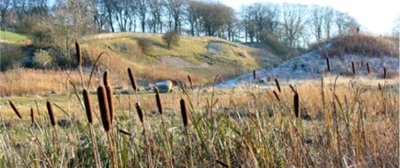26. Petershill Quarries, north east Bathgate
The main rock in this quarry is a band of limestone, rich in fossils, which formed in an otherwise predominantly volcanic environment about 330 million years ago.

This area was a limestone quarry during the 18th century and was converted to a reservoir in the 19th century, but this was closed in 1986. It now includes areas of species-rich grassland, scrub and wetland, as well as being an important geological site. It is a Wildlife Reserve managed by Scottish Wildlife Trust.
These quarries illustrate a sequence of sedimentary rocks which were formed about 325 million years ago during the middle of the Carboniferous Period. The main rock is a band of limestone formed in what was otherwise a predominantly volcanic environment. This limestone, called the Petershill Limestone is famous for its well preserved marine fossils. These are of immense significance and many species have been described from this site. Thick beds of limestone are visible at the southern end of the quarries. The Petershill Quarries are a Site of Special Scientific Interest (SSSI) due to them being a good example of rocks of the middle Carboniferous Period and also because of the lowland neutral and calcareous grassland.
The quarries are located on the north-eastern outskirts of Bathgate, off Drumcross Road. Car parking and the public entrance are situated to the south-west of the reserve and are signposted. Take care not to impede access to Bughtknowes Farm and respect the adjacent farmland. Nearby geodiversity sites are East Kirkton Quarry (4), Rifle Range Quarries (27) and The Knock (38).



